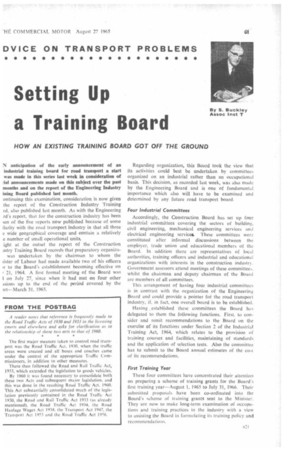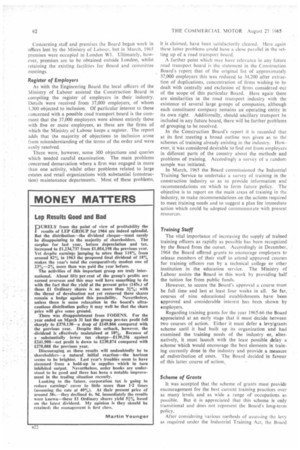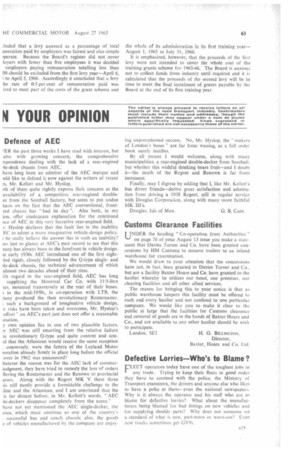Setting Up a Training Board
Page 63

Page 64

Page 65

If you've noticed an error in this article please click here to report it so we can fix it.
HOW AN EXISTING TRAINING BOARD GOT OFF THE GROUND N anticipation of the early announcement of an industrial training board for road transport a start was made in this series last week in consideration of lai announcements made on this subject over the past months and on the report of the Engineering Industry ining Board published last month.
ontinuing this examination, consideration is now given the report of the Construction Industry Training rd. also published last month. As with the Engineering rd's report. that for the construction industry has been sen of the five reports now published because of some ilarity with the road transport industry in that all three e wide geographical coverage and contain a relatively e number of small operational units.
ight at the outset the report of the Construction Listry Training Board records that preparatory organiza was undertaken by the chairman to whom the iister of Labour had made available two of his officers or to the Board's establishment becoming effective on 21, 1964. A first formal meeting of the Board was on July 27, since when it had met on four other tsions up to the end of the period covered by the )rt—March 31. 1965, Regarding organization, this Board took the view that its activities could best be undertaken by committee, organized on an industrial rather than an occupational basis. This decision, as recorded last week, was also made by the Engineering Board and is one of fundamental importance which also will have to be examined and determined by any future road transport board.
Four industrial Committees
Accordingly, the Construction Board has set up four industrial committees covering the sectors of building, civil engineering, mechanical engineering services and electrical engineering services. These committees were constituted after informal discussions between the employer, trade union and educational members of the Board. In addition there are representatives of local authorities, training officers and industrial and educational organizations with interests in the construction industry . Government assessors attend meetings of these committees. whilst the chairman and deputy chairman of the Board are members of all committees.
This arrangement of having four industrial committees is in contrast with the organization of the Engineering Board and could provide a pointer fol. the road transport industry, if, in fact, one overall board is to be established.
Having , established these committees the Board has delegated to them the following functions. First, to consider and remit recommendations to the Board on the exercise of its functions under Section 2 of the Industrial Training Act, 1964, which relates to the provision of training courses and facilities, maintaining of standards. and the application of selection tests. Also the committee has to submit to the Board annual estimates of the cost of its recommendations.
First Training Year
These four committees have concentrated their attention on preparing a scheme of training grants for the Board's first training year—August 1, 1965 to July 31, 1966. Their submitted proposals have been co-ordinated into the Board's scheme of training grants sent to the Minister. They are now to make long-term examination of occupations and training practices in the industry with a view to assisting the Board in formulating its training policy and recommendations.
Concerning staff and premises the Board began work in offices lent by the Ministry of Labour, but in March, 1965 premises were occupied in London WI. Ultimately, however, premises are to be obtained outside London, whilst retaining the existing facilities for Board and committee meetings.
Register of Employers
As with the Engineering Board the local officers of the Ministry of Labour assisted the Construction Board in compiling the register of employers in their industry. Details were received from 37,000 employers, of whom 1,300 objected to inclusion. Of particular interest to those concerned with a possible road transport board is the comment that the 37,000 employers were almost entirely those with five or more employees, as these are the firms of which the Ministry of Labour keeps a register. The report adds that the majority of objections to inclusion arose from misunderstanding of the terms of the order and were easily resolved.
There were, however, some 300 objections and queries which needed careful examination. The main problems concerned demarcation where a firm was engaged in more than one activity, whilst other problems related to large estates and retail organizations with substantial (construction) maintenance departments. Most of these problems, it is claimed, have been satisfactorily cleared. Here again these latter problems could have a close parallel in the setting up of a road transport board.
A further point which may have relevance in any future road transport board is the statement in the Construction Board's report that of the original list of approximately 37,000 employers this was reduced to 34,200 after extraction of duplications, concentration of firms wishing to be dealt with centrally and exclusion of firms considered out of the scope of this particular Board. Here again there are similarities in the road transport industry with the existence of several large groups of companies, although each constituent company remains an operating entity in its own right. Additionally, should ancillary transport be included in any future board, there will be further problems of grouping to be resolved.
In the Construction Board's report it is recorded that at its first meeting a broad outline was given as to the
schemes of training already existing in the industry. However, it was considered desirable to find out from employers in different parts of the country about the methods and problems of training. Accordingly a survey of a random sample was initiated.
In March, 1965 the Board commissioned the Industrial Training Service to undertake a survey of training in the construction industry so as to provide information and recommendations on which to form future policy. The objective is to report on the main areas of training in the Industry, to make recommendations on the actions required to meet training needs and to suggest a plan for immediate action which could be adopted commensurate with present resources.
Training Staff
The vital importance of increasing the supply of trained training officers as rapidly as possible has been recognized by the Board from the outset. Accordingly in December, 1964 the Board offered grants to encourage employers to release members of their staff to attend approved courses for training officers run by a technical college or other institution in the education service. The Ministry of Labour assists the Board in this work by providing half the tuition fee from public funds.
However, to secure the Board's approval a course must be full time and last at least four weeks in all. So far, courses of nine educational establishments have been approved and considerable interest has been shown by employers.
Regarding training grants for the year 1965-66 the Board appreciated at an early stage that it must decide between two courses of action. Either it must defer a levy/grants scheme until it had built up its organization and had examined the training needs of the industry or, alternatively, it must launch with the least possible delay a scheme which would encourage the best elements in training currently done in the industry and provide a measure of redistribution of costs. The Board decided in favour of this latter course of action..
Scheme of Grants
It was accepted that the scheme of grants must provide encouragement for the best current training practices over as many levels and as wide a range of occupations as possible. But it is appreciated that this scheme is only transitional and does not represent the Board's long-term policy.
After considering various methods of assessing the levy as required under the Industrial Training Act, the Board :luded that a levy assessed as a percentage of total uneration paid by employers was fairest and also simple merate. Because the Board's register did not cover loyers with fewer than five employees it was decided employers paying remuneration totalling less than 00 should be excluded from the first levy year—April 6, to April 5, 1966. Accordingly it concluded that a levy he rate of 0.5 per cent of remuneration paid was ired to meet part of the costs of the grant scheme and the whole of its administration in its first training year— August 1, 1965 to July 31, 1966.
It is emphasized, however, that the proceeds of the first levy were not intended to cover the whole cost of the training grants scheme for 1965-66. The Board is anxious not to collect funds from industry until required and it is calculated that the proceeds of the second levy will be in time to meet the final instalment of grants payable by the Board at the end of its first training year.












































































































